| |  The third part of this series covers objects found in the UK from Roman to Modern times. The clear line drawings and colour pictures again help the finder with identification. The contents are: Casket, Chest & Door Keys, Medieval Purse Holders, Brass Lettering From Tombs, Pilgrims Ampullae, Pewter Medical Syringes, Snake Form Belt Hooks, Luggage & Dog Collar Name Plates, Finger Rings, Roman & Saxon Pins, Walking Stick Tops & Ferrules, Bronze Pot Legs, Decorative Lead Discs, Chess Pieces, Horseshoes, Medieval Barrel Locks & Keys, Medieval Candle Holders, Clay Tobacco Pipes, Belt Decorations, Decorative Pouring Spouts, Saddle Pommels, Bayonet Scabbard Hooks, Lace Tags, Door & Window Latches, Medieval Pins, Posy & Mourning Rings, Silver Pins & Bodkins, Cosmetic Implements, Clothing Accessories. The third part of this series covers objects found in the UK from Roman to Modern times. The clear line drawings and colour pictures again help the finder with identification. The contents are: Casket, Chest & Door Keys, Medieval Purse Holders, Brass Lettering From Tombs, Pilgrims Ampullae, Pewter Medical Syringes, Snake Form Belt Hooks, Luggage & Dog Collar Name Plates, Finger Rings, Roman & Saxon Pins, Walking Stick Tops & Ferrules, Bronze Pot Legs, Decorative Lead Discs, Chess Pieces, Horseshoes, Medieval Barrel Locks & Keys, Medieval Candle Holders, Clay Tobacco Pipes, Belt Decorations, Decorative Pouring Spouts, Saddle Pommels, Bayonet Scabbard Hooks, Lace Tags, Door & Window Latches, Medieval Pins, Posy & Mourning Rings, Silver Pins & Bodkins, Cosmetic Implements, Clothing Accessories. |
| | | 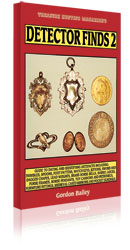 The second volume of finds, again with hundreds of illustrations, forms an additional invaluable aid to identifying finds. The contents include: Purse Frames, Pocket Sundials, Medieval Handles, Thimbles, Furniture Fittings, Sentimental Brooches, Baldrick Buckles, Watch Keys, Lead Weights, Cased Mirrors, Toy Cannons, Cuff Links, Nut Crackers, Petronels, Sword Belt Fitments, Scissors, Horse Pendants, Foot Pattens, Wine Labels, Barrel Locks and Keys, Palm Guards, Button Hooks, Dividers, Sword and Dagger Chapes, Brass Horse Bells, Jaws Harps, Hatpins, Lead "Bells", Spoons, Scabbard Fitments, Sheet Metal Bells, Miniature Domestic Utensils and Jettons The second volume of finds, again with hundreds of illustrations, forms an additional invaluable aid to identifying finds. The contents include: Purse Frames, Pocket Sundials, Medieval Handles, Thimbles, Furniture Fittings, Sentimental Brooches, Baldrick Buckles, Watch Keys, Lead Weights, Cased Mirrors, Toy Cannons, Cuff Links, Nut Crackers, Petronels, Sword Belt Fitments, Scissors, Horse Pendants, Foot Pattens, Wine Labels, Barrel Locks and Keys, Palm Guards, Button Hooks, Dividers, Sword and Dagger Chapes, Brass Horse Bells, Jaws Harps, Hatpins, Lead "Bells", Spoons, Scabbard Fitments, Sheet Metal Bells, Miniature Domestic Utensils and Jettons |
| | | 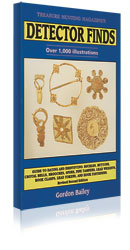 This is the first of SEVEN "Finds" books by the ever popular Gordon Bailey, and contains over 1,000 illustrations. It is designed to help metal detectorists This is the first of SEVEN "Finds" books by the ever popular Gordon Bailey, and contains over 1,000 illustrations. It is designed to help metal detectorists
identify finds. The contents of this volume cover Buckles, Clog & Shoe Clasps, Buttons, Hook Fasteners, Gun Money, Crotal and Rumbler Bells, Love Tokens, Ring Brooches, Lead Artefacts, Hawking Bells and Whistles, Pipe Tampers, Candle Snuffers, Hasps and Clasps, Copper Nails, Horse Decorations, Pomanders, Spurs and Pastry Jiggers. |
| | | 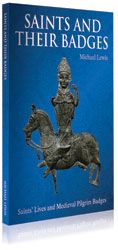
Pilgrim badges were bought by pilgrims visiting holy sites across Europe, partly as souvenirs, but also for the mystical properties these badges were believed to absorb when touched to holy relics. Such pilgrim trinkets are not common metal-detected finds, but given their fragile nature it is quite possible many metal detectorist have found them without realising it, perhaps even throwing them away! Many badges are unassuming little lead- or copper-alloy objects, but others have intricate designs, and can even be made of precious metal. This book offers an introduction to some of the more common badges, also giving further information on pilgrimage in the medieval period and the saints’ lives these badges celebrate.
Dr. Michael Lewis is Deputy Head of thePortable Antiquities Scheme and Curator, Medieval Collections, British Museum. He is a Fellow of the Society of Antiquaries of London and a Member of the Institute for Archaeologists. He has a particular interest in the archaeology and history of the ‘medieval’ period from about AD 1000.
ISBN978-1-897738-55-9
168pp 250mm x 190mm
£22.95
|
| | | 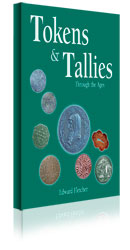
There is no universally accepted agreement on what is or is not a token, nor even a tally. In this book the terms token and tally mainly cover those metal objects for which there is some historical or archaeological evidence that they served either as substitutes for denominations of legal money in short supply, or as a means of recording promised payments and services due, or as a method of keeping account of time, of possessions, of work output, or of the many other things humans felt a need to count and record. The accompanying texts and illustrations serve as an introduction to each category. The recommended bibliographies should put readers on the road to expertise in all of these fascinating series. |
| | | 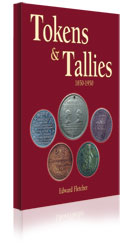
The massive social changes that took place during 1850-1950 are reflected on the designs of the small pieces of brass, copper, lead, plastic or embossed card used in the manufacture of these intriguing items of paranumismatica, with issuers ranging from public houses to chapels and co-operative establishments. With over 700 photographs covering much of the range of rare and not-so-rare tokens available to the collector, this book is an invaluable source of information to both the beginner and experienced collector alike. |
|
|




